Kubuntu for Windows Users: With Microsoft officially ending Windows 10 support and the rollout of Windows 11 continuing to puzzle many users with its AI-driven experiments and strict hardware rules, there has been a dramatic rise in interest toward Linux. Among the many distributions available, one option consistently stands out as the most Windows-friendly choice: Kubuntu.
In 2025, Kubuntu has quietly evolved into one of the most polished, intuitive, and hardware-efficient Linux distros available—and more importantly, it feels familiar without being restrictive. For users frustrated with Windows updates, performance issues, or privacy concerns, Kubuntu provides a refreshing, surprisingly powerful alternative.
⭐ A Familiar Look: Why Kubuntu’s Interface Makes Switching Easy
One of the most intimidating aspects of moving from Windows to Linux is the user interface. Most newcomers ask the same questions:
- How do I open apps?
- Where are my settings?
- How do I install software?
Kubuntu’s answer is simple: by looking and acting like Windows—without the clutter.
Kubuntu for Windows Users: A Start Menu That Feels Instantly Comfortable
Kubuntu uses the KDE Plasma desktop environment, widely considered one of the most advanced and customizable interfaces in the Linux world. However, Plasma’s familiarity is its greatest strength.
The default layout includes:
- A bottom taskbar
- A Windows-style Start menu
- System tray icons
- A search-friendly applications menu
Unlike GNOME (used by standard Ubuntu), Plasma doesn’t radically reshape the desktop model. Instead, Kubuntu mirrors the classic Windows workflow. You click “Start,” browse your apps on the left, and see your favorite pinned programs on the right—very much like Windows 10.
Settings That Actually Make Sense
Windows is infamous for scattering settings across multiple menus, especially with the ongoing mix between the legacy Control Panel and the newer Settings interface.
Kubuntu avoids this problem with a single, unified Settings app. There’s no confusion, no duplicates, no outdated menus—just one place for every configuration option.
Many users even argue that KDE Plasma’s Settings panel is more neatly organized than Windows 11’s settings, which try to bridge modern UI and old Windows architecture.

🧰 Better Default Apps Than Windows (Really)
People expect their operating system to “just work” as soon as they install it. Kubuntu delivers that by including a curated selection of KDE applications that cover nearly every essential task.
Some standout defaults include:
Dolphin File Manager
A powerful and intuitive file explorer that many users consider superior to Windows File Explorer thanks to:
- Dual-pane support
- Tabs
- Built-in file previews
- Faster navigation
Konsole Terminal
Even if you rarely use the terminal, Konsole is fast, clean, and extremely customizable.
Okular Document Viewer
A versatile PDF/document app that rivals commercial alternatives.
Spectacle Screenshot Tool
Windows’ Snipping Tool has finally improved, but Spectacle remains smoother, faster, and offers more export options.
KDE Connect: A Game-Changer
If there’s one app that surprises former Windows users the most, it’s KDE Connect, which allows seamless communication between your Linux PC and phone.
With KDE Connect you can:
- Send/receive text messages
- Control your phone from your PC
- Share files wirelessly
- Sync clipboard content
- Use your phone as a remote control
Compared to Microsoft’s Phone Link app, KDE Connect is known for being:
- Faster to pair
- More reliable
- Less restricted
- Fully free and open source
For many Windows switchers, KDE Connect alone makes Kubuntu feel more modern and cohesive than Windows 11.
🖥️ A Massive Ecosystem of Apps and Support
Under the surface, Kubuntu is based on Ubuntu, which is itself powered by Debian, one of the oldest and most stable Linux foundations.
This means:
- You get enormous documentation online
- Millions of tutorials already exist
- Software support is massive
- Community troubleshooting is easier
If you ever hit a technical roadblock, chances are excellent that someone has already solved it—and posted the solution.
The only part where Ubuntu’s GNOME documentation doesn’t directly apply is the desktop environment. But KDE Plasma is extremely popular in its own right and has huge community support.

🚀 Performance: Kubuntu Runs on Almost Anything
Windows 11 has notoriously strict hardware requirements:
- TPM 2.0
- Newer generation CPUs
- 4GB RAM minimum
- UEFI secure boot
Kubuntu?
It’ll run on computer parts old enough to vote.
People routinely install Kubuntu on:
- 10+ year old laptops
- Budget PCs with 4GB RAM
- Lightweight fanless mini-PCs
- Refurbished office desktops
When comparing performance on older machines, Kubuntu often feels smoother than Windows 10 and dramatically faster than Windows 11.
Many users report that installing Kubuntu on a struggling laptop effectively “revives” it—turning a slow Windows device into a responsive, usable computer again.
And if your machine still feels sluggish, KDE Plasma allows you to reduce animations and transparency without affecting usability.
🎮 Yes—Linux Gaming Is Real Now
There was a time when using Linux meant abandoning gaming, but that era is over. Thanks to Proton, Valve’s compatibility layer built into Steam, most Windows games now run flawlessly on Linux.
Modern Kubuntu can handle titles such as:
- Elden Ring
- Baldur’s Gate 3
- GTA V
- Cyberpunk 2077
- Halo: MCC
As long as you’re using Steam, most supported games launch with zero configuration.
For many gamers, the biggest surprise is that some titles run better on Linux due to fewer background processes and better resource management.
🎯 Why Kubuntu Is the Most Windows-Friendly Linux Distro in 2025
Putting everything together, Kubuntu offers:
- A Windows-like interface
- Better built-in apps
- Massive documentation
- Freedom from Windows bloat
- Exceptional performance on old hardware
- Easy software installation
- Strong gaming support
- Full control over updates
- No requirement for proprietary hardware features
Unlike some Linux distros aimed at power users, Kubuntu strikes a balance between familiarity and enhanced control.
🧭 Final Verdict: Kubuntu Is the Easiest, Cleanest, Most Polished Transition Path for Windows Migrants
Switching operating systems used to be intimidating. But in 2025, the combination of Ubuntu’s stability and KDE Plasma’s modern interface makes Kubuntu feel like the logical next step for millions of Windows users looking for speed, privacy, and freedom.
Whether you’re trying Linux out of curiosity or planning to leave Windows permanently, Kubuntu offers a smooth, friendly, and surprisingly powerful experience.

